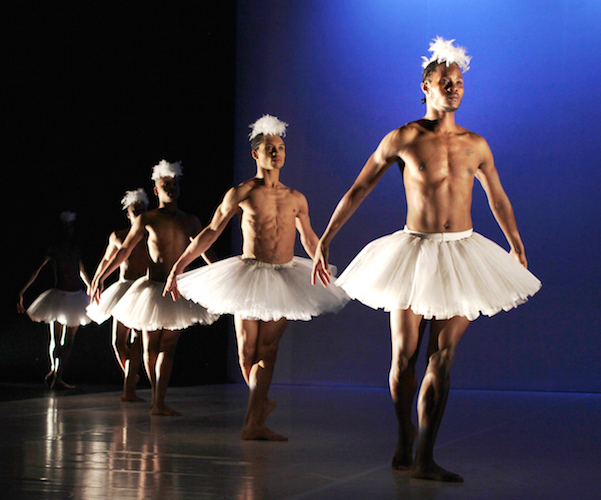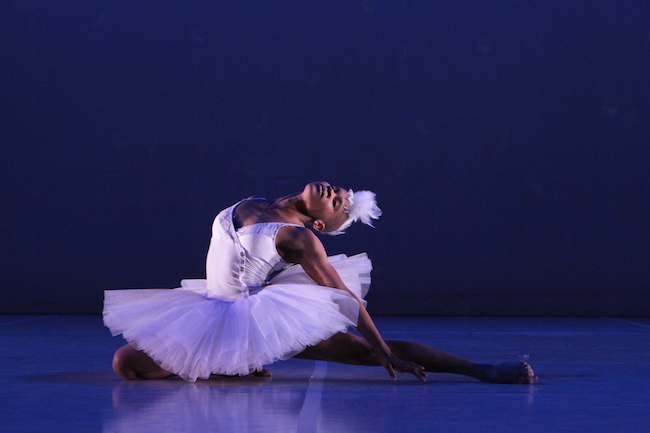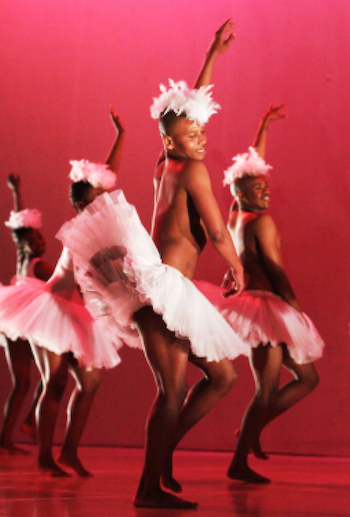Dance Review: Dada Masilo’s “Swan Lake” — An Entertainment Full of Heart and Art
South African choreographer Dada Masilo goes even further into the Swan Lake fantasy: here, the characters, men and women, are all swans.
Dada Masilo’s Swan Lake at UMass Amherst’s Fine Arts Center, Amherst, MA on January 26.

A scene from Dada Masilo’s version of “Swan Lake.” Photo: John Hogg.
By Janine Parker
Although South African choreographer Dada Masilo’s Swan Lake, a wildly exuberant, often cheeky version of the warhorse, mines traditional productions for laughs, she isn’t interested in dissing or dismissing “serious” Swan Lakes. She’s laughing, yes, but with great affection, at the things in ballet that can be a tad ridiculous, especially when they are taken out of context.
Masilo knows well the 1895 version, co-choreographed by Lev Ivanov and Marius Petipa, that most subsequent productions have been drawn from. She has said that she, like many young dancers, dreamed of one day dancing in such a Swan Lake, though it became clear to her that, as a dancer, she wasn’t going to attain that position in a classical ballet company. If this was a bitter realization, it doesn’t come across in this production, whose strong doses of humor are laced with fondness rather than snarkiness.
Still, slyly, she begins her own Swan Lake stodgily. Entering stiffly, the dancers walk and pause, posing with the swan port de bras we’re familiar with, arms above, softly curved at the elbows then cragged at the wrists. Their movements are robotic and dulled, leeched of poetry. The point is not that ballets like Swan Lake are hopelessly obsolete, but that the onus is on directors and dancers — as it has always been, even back in 1895 — to present exquisitely detailed, fully fleshed performances of top-notch quality. “Phoning it in” just won’t cut it. Audiences must be drawn into these fantasy worlds.
The most obvious clue that Masilo isn’t just parodying Swan Lake is that her version dives into both the fantasy and the tragedy at its heart. While she tweaks some of the details, the story of her swans, like Ivanov/Petipa’s, is about the relationships between humans, the messy businesses of love and power. In most productions, a young prince, Siegfried, is told by his mother that it’s time to choose a bride. Rejecting the comely maidens offered to him, he instead falls in love with Odette, who, along with her friends, is under a spell that transforms them into swans during the day. The spell, cast by the sorcerer Von Rothbart, can only be broken by another’s vow of love. No problem — Siegfried’s head over heels — until Von Rothbart and his daughter, Odile, trick Siegfried into inadvertently breaking his vow.
In some ways, Masilo goes even further into the original fantasy: here, the characters, men and women, are all swans, the cast of multi-hued dancers all fluffy-butted in the white tutus meant to conjure swansdown. They all sport a mohawk-like strip of white feathers on their heads, too. (The costume design is by Masilo and Suzette le Sueur, and the “hats” are by Karabo Legoabe.) As in the past, Masilo calls on the viewer’s willingness to suspend reality, even though she projects the material through an updated lens. Her Siegfried is gay, but closeted. Masilo has spoken of her desire to confront the homophobia of her birthplace through such re-interpretations.
Of course, this isn’t terra incognita; in his well-known 1995 production, Matthew Bourne’s Siegfried was also gay. Nor is the one male swan dancing on pointe (everyone else is barefoot) a new idea — the members of Les Ballets Trockadero de Monte Carlo have been at it for decades. Refreshingly, this is a revision that has not offered up for giggles. Bourne’s swan corps de ballet are all men and dance with a defiant, bare-chested brawn, perhaps the choreographe’s way of unequivocally showing that yes, he’s cast males in this formerly all-female milieu, but they are all still Manly Men.
I like Bourne’s male swan corps, and greatly appreciate the leap forward it represented. Bourne wasn’t the only choreographer bending the gender “rules,” but his built-for-commercial-theater production meant that it has been seen by legions more than ever attend a dance concert. But I also like how, while Masilo doesn’t “neuter” her male and female swans, there is little in the ample ensemble sections that suggests “gender-specific” choreography. The women do wear white bodices with their tutus, and sometimes the sexes are divided — now the women dance these phrases, while the men pose and wait, and vice versa — but overall there isn’t a his and hers effect.
Still, Masilo doesn’t ignore the male/female designation that remains standard practice in ballet, nor other balletic tropes. It is when it examines these gender roles that this Swan Lake is at its most farcical. In a giddy section at the beginning, Nicola Haskins (in the dual role of Master of Ceremony and Siegfried’s Mother) recites bits of humorist Paul Jennings’ satiric essay “Backwoon Four Up,” written from the (supposed) point of view of a person going to the ballet for the first time. Like a crazed professor in a lecture hall, Haskins weaves among the dancers and “explains” the ballet to us. When the men enter, she proclaims they should “leap about doing what we think of as the Virility Splits.” The women, meanwhile, should employ lots of “Twiddletoes” and “Seaweed Arms, all that graceful frond-like waving stuff.” The essay is hilarious, and Haskin’s delivery is spot-on.

A scene from Dada Masilo’s “Swan Lake’.” Photo: John Hogg.
Masilo has a talent for visual humor — I contend it’s one of the hardest things to pull off successfully in dance — and the laughs are exactly where she wants them to be. As if with the wave of a magician’s wand the comedy morphs into sincerity: her dancers slip between slapstick and sublimity on the turn of a dime. From the moment we see Thamsanqa Tshabalala’s long, sinuous body wafting on stage in those ubiquitous bourrées, there’s no sense of uncertainty, no nervous titters about the pointe shoes. In another good twist, by the way, Tshabalala is portraying Odile, usually the (female) decoy whose black costume is the visual metaphor for her “evilness,” the contrast to Odette’s white costume, which, natch, conveys her “purity.” But remember, all of Masilo’s swans, Odile included, are in white; they are all “innocent” — even Siegfried’s outrageously obnoxious parents.
This particular convention, by the way, this white-and-black conceit, should be chucked out of Swan Lake productions. Couldn’t we get the same idea with, I don’t know, shades of amber and green? Seems a bit tone-deaf to the widespread lack of diversity in our ballet companies, no? In any event, if Masilo is commenting on this issue, it’s pretty obliquely. (Maybe, the uncredited stage design — a white marley floor and white background bordered by the theater’s black curtains and legs — is making a statement, or perhaps it’s just a striking look.) It’s lovely to think that the onstage equality of her black, brown, and white dancers speaks for itself.
One of the most satisfying things about this piece is its generous amount of pure dancing. Though anchored in ballet vocabulary, Masilo also uses a fair amount of modern and African dance-based movements. The score is likewise a mashup, stretches of Pyotr Tchaikovsky’s original score interspersed between bursts of music by Steve Reich and Arvo Pärt. Camille Saint-Saëns’ “Dying Swan” is — oh, why not? — tossed into the mix. Masilo’s birds of a feather frequently flock, but they also shriek, yip, chant, and chatter, adding to the aural hodgepodge.
The transitions among genres happen as they should, seamlessly; if the steps are somewhat generic, it’s one of the reasons the production works. The ingredients are simple and complementary; they blend without being bland. Thus, gloriously big attitude turns, piqué arabesques, and pas de chats slip into silky rolls to the floor or flat-footed weight shifts of the legs, heads diving torsos into undulations. Arms move from swan port de bras to Masilo’s quicksilver, often circular patterning with liquid clarity.

A scene from Dada Masilo’s version of “Swan Lake.” Photo: John Hogg.
Indeed, when the dancers dance they seem to never stop moving, abuzz all the time; there is a near-constant shimmer and shake in their hips, a hint of African dance, yes, but there’s also something James Brownian about it, an impish boisterousness. The company is fabulous and, to be sure, Masilo, dancing the role of Odette, is their queen swan. Her performance is a compelling study in contrasts. She’s not tall, but moves with an Amazonian power; sometimes, while she struts her lower body in propulsive staccato, her back undulates with a cat’s luxuriousness.
Aside from the excerpts from Jennings’ essay, there is some linearly spoken text, too (in English during this first-ever U.S. tour; the troupe will perform this show at The Joyce Theater in New York City February 2-7). As he traverses the stage in his solo, now upright, his limbs cantilevered in long diagonal lines, now softly sliding and rolling on the floor, Siegfried speaks haltingly of his dilemma. “It is impossible. I can’t marry her,” he says of Odette, who has been “bought” for him. (It’s that pointe-shoed Odile who captures Siegfried’s fancy.) Usually Siegfried is cruelly fooled by Von Rothbart, that sorcerer. This Siegfried, performed by Songezo Mcilizeli, is woebegone throughout; it’s clear to him that his situation is hopeless. The decks are stacked against him from the get-go, but the difference here is that he knows it before everyone else does.
The gorgeous, spirited dancing, the infectious charm and big-natured humor make for a hugely satisfying dance-theater experience. But Masilo goes further, daring to add Siegried’s struggle and melancholy. This Swan Lake ends on a beautifully elegiac note: the dancers are now costumed in simple, long, handsome dark skirts, everyone now, male and female, bare-chested. The disappearance of the fluffy-butted tutus is more than a costume change, it’s a transformation for the dancers and for us. This twilit ending is a masterstroke of artistic rightness: solemn without being sentimental, the dancers’ arms and torsos now undulate languidly, as if they’d exorcised all the freneticism out of their bodies in the previous hour. Simple phrases are repeated, mostly in canon, by the dancers scattered about the stage. A sum effect of calm descends. It’s not a “happy” ending, but it’s a cathartic one.
The fun stuff is exuberant; the laughs come easily, but deeply, from the belly. The solemnity resonates internally too, though a bit higher up in the chest. Masilo has achieved something rare with her Swan Lake; it’s an entertainment that is full of heart and art, a poetic experience that seems to cleanse and cure us, at least for a few precious moments after the house lights come up.
Since 1989, Janine Parker has been writing about dance for The Boston Phoenix and The Boston Globe. A former dancer, locally she performed with Ballet Theatre of Boston, North Atlantic Ballet, Nicola Hawkins Dance Company, and Prometheus Dance. Ms. Parker has been teaching for more than 25 years, and has a long history with Boston Ballet School. She is on the Dance Department faculty of Williams College in Western Massachusetts, where she has lived since 2003. Janine Parker can be reached at parkerzab@hotmail.com.
Tagged: Dada Masilo, Dance Factory Johannesburg, Janine Parker, South Africa, Swan-Lake
